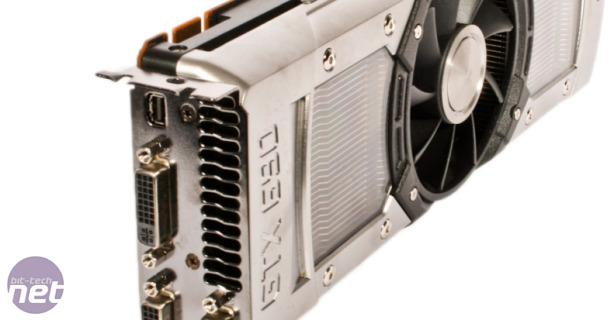Cooling Results
We used a reference GeForce GTX 690 4GB to test the cooling options and opted for a typical water-cooling loop with a quad 120mm-fan radiator and Laing D5 pump to test the EK waterblock. Both setups were enclosed in a Silverstone TJ11 case We recorded the temperatures using GPU-Z, while running Unigene's Heaven benchmark for 30 minutes to allow the temperatures to level off at their peaks.Performance Analysis
After 30 minutes under full load for each setup, we recorded the peak temperatures, the results of which were pretty surprising. The reference cooler of the GeForce GTX 690 4GB has always struck us as appearing to be more than up to the job, however with a delta T of 63°C it was a huge amount warmer than our other setups.
For an air cooler, the Accelero Twin Turbo 690 put in a pretty impressive showing, managing to keep the GPU below a delta T of 35°C, that's 28°C cooler than the reference cooler - a fantastic result. What's more it remained incredibly quiet, even under load.
However, if ever there was an advert for water-cooling your graphics card, the EK-FC690 GTX
waterblock is it. The delta T it recorded was nothing short of astonishing - just 15°C, with the temperature not rising more than 10°C from idle to load. This is a massive 48°C lower than the reference cooler, and again it's a fair bit quieter too. In contrast, the reference cooler span up to quite a din during testing.
Conclusion
If you're keen to boost your overclocking headroom or reduce the noise your graphics card makes, then what is your best option?
With our fears over the Accelero Twin Turbo 690's somewhat tricky installation laid to rest, the case for third party air coolers is relatively sound. It beat the pants off the reference cooler and you'll obviously not have the complication or expense of a water-cooling system to contend with. That said, the air isn't exhausted out your case so you'll have to consider how it affects other parts of your system, plus the Accelero Twin Turbo 690 will still set you back over £80.
Click to enlarge
As for water-cooling, well, in terms of performance, the case is just about as strong as it possibly could be. What's more, water-cooling your PC is pretty easy these days.
However, as has always been the case, the main issue with water cooling is price. Even using a cheaper waterblock for a less powerful graphics card will still see you spending over £150 for graphics card-only setup. But, a majority of the kit you buy will be an investment. We realised quite recently that in many of our home PCs, the pump is now one of the oldest components, and transplanting your radiator, pump, fittings, reservoir and maybe even the tubing to another system is straightforward.
The likelihood is, then, that the only time you'll need to buy anything new for a system upgrade will be a new waterblock for your graphics card; if you owned an LGA1156 waterblock, chances are you could have transplanted it into your LGA1155 system.
Also worth considering is that you're possibly more likely to be able to fit a dual or triple 120mm-fan radiator in your system than an extremely large third party air cooler such as the Accelero Twin Turbo 690.
Overall, though, what is clearest from our tests is that reference coolers, even on the most expensive graphics cards are far from perfect. The cooler on the stock GeForce GTX 690 4GB looks hefty enough but while it's up to the job, there's a huge amount of room for improvement, which was tapped into with our third party cooling options. Personally, despite the expense, we'd opt for water cooling. It's far easier to fit a waterblock to your graphics card than all the air coolers we've tested over the years, it offers the best cooling by far and of course you get all the other advantages of a water cooled system.
EK-FC690 GTX Waterblock

Arctic Accelero Twin Turbo 690

-
Value25 / 30
-
Cooling34 / 40
-
Design23 / 30


MSI MPG Velox 100R Chassis Review
October 14 2021 | 15:04










Want to comment? Please log in.